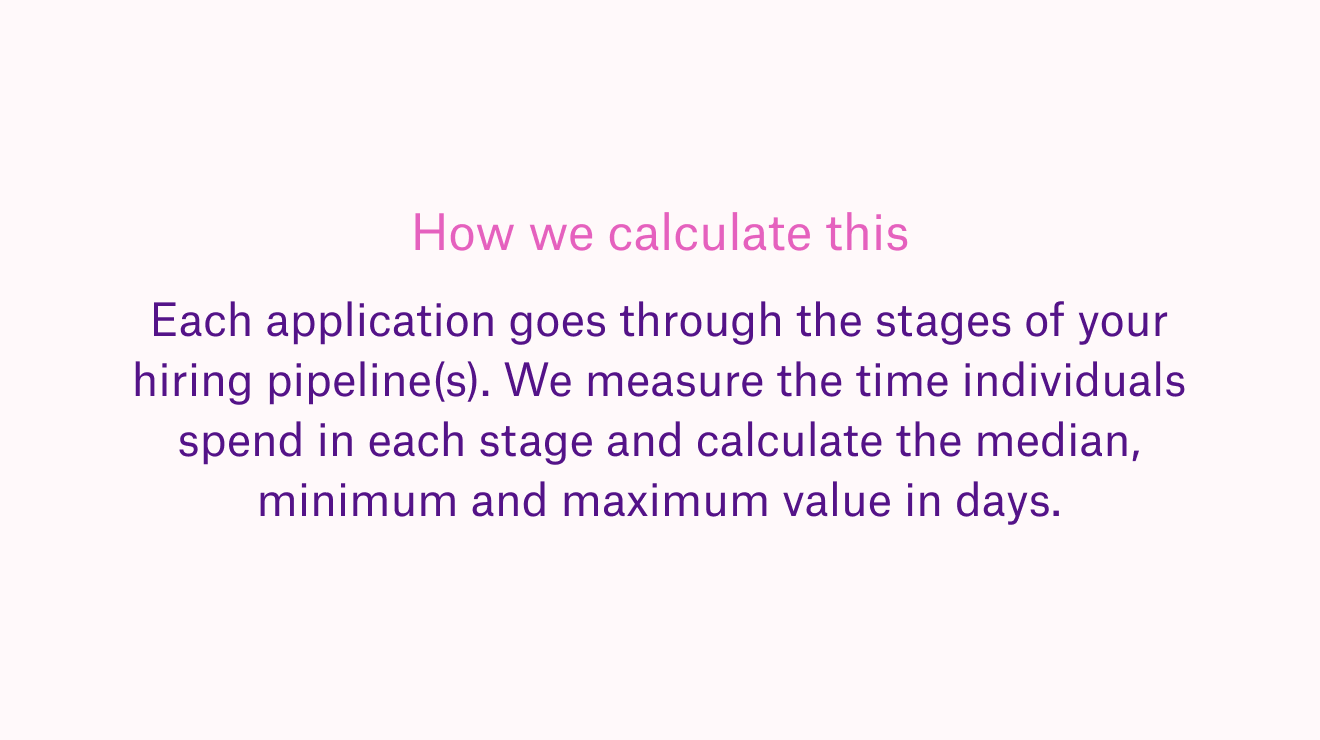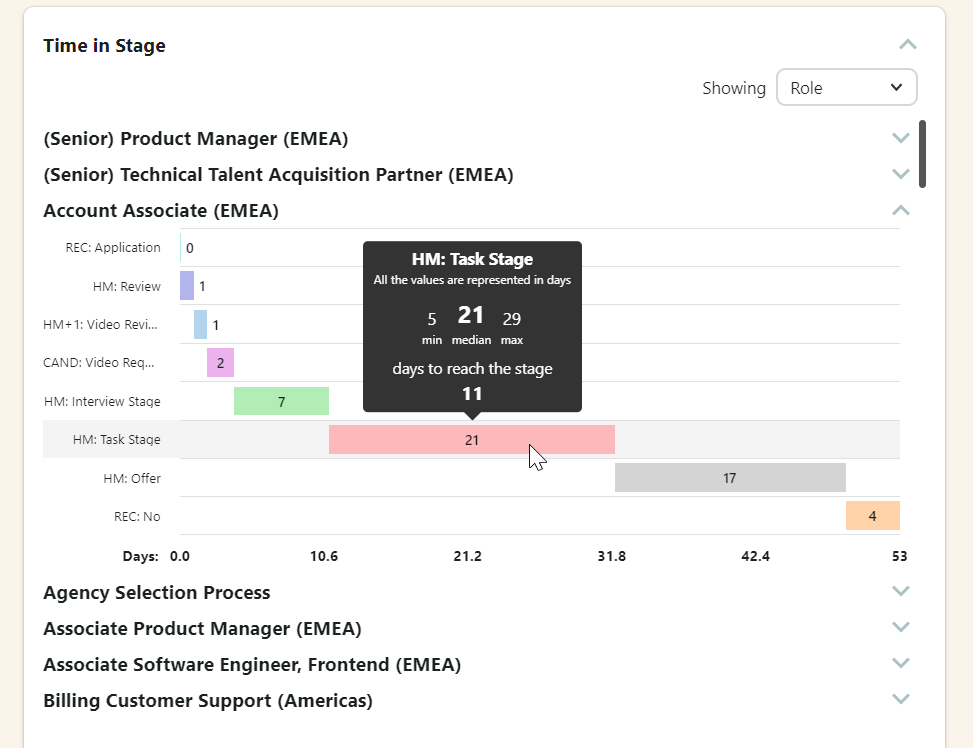Are you losing candidates because they spend too much time waiting? Here’s how to measure time in recruitment stage to uncover hiring process bottlenecks.
We are in a war for talent. This statement has never been truer. COVID-19 has made people rethink their careers, working conditions and long-term goals. This is how the time of the Great Resignation started. Employees are seeking to gain better work-life balance. This has almost become a non-negotiable and among the primary reasons to look for a new job.
If you are an Employer looking to grow and scale your business fast, your recruitment team is under a lot of pressure. The ultimate goal is to bring in talent fast while making sure your candidates have the best possible experience throughout your hiring process.
Constantly inspecting all elements of your recruitment process such as how much time candidates spend in specific recruitment stages becomes an imperative to uncover any inefficiencies that are delaying your hire or causing candidates to drop out.
What is time in recruitment stage?
Time in recruitment stage is a metric that shows how much time candidates spend in each phase of the recruitment cycle.
Alongside the time to hire and time to fill metrics, time in recruitment stage will help your recruitment team be more efficient and remove bottlenecks that are delaying the hiring process. Moving faster in your candidate evaluation process will help you lose fewer great candidates to talent competitors.
Why measure time in recruitment stage
The average time to hire is somewhere around 43 days from the day you open a job post to the final offer. Measuring time in recruitment stage can help you pinpoint where you need to invest more thought on how to reduce the time the candidate needs to go through an evaluation. At the same time, it helps you ensure that you’re giving yourself and the candidate enough time and information to evaluate if you are a match.
Understanding the time your candidates need to go through the hiring process from the moment they apply to the moment they get an offer or a rejection letter moves you one step closer to creating a smooth and pleasant experience for the candidate. At the same time, it directly influences the time your recruitment team needs to get to a hire.
One of the most important aspects of the candidate experience is clear, timely and direct communication on what they can expect as the next step throughout the recruitment process. If you are unable to provide accurate information, or delays are happening due to internal inefficiencies, your candidate may wonder if they want to work in a place where their time is not respected.
Time is of the essence both in the sense of business priorities and the role you are hiring for, but also in getting first to the candidates you would like to hire. Measuring time to hire helps you keep the balance between speed and quality. In the long run, this helps your organization improve its quality of hire.
You want to know how many days candidates spend in each stage of your recruitment cycle. Your star candidate might be interviewing with other companies and should they beat you to the job offer because they were faster to evaluate the candidate and make a decision to hire, you will need go back to sourcing, which ultimately delays your time to hire.
Let’s explore how to calculate the time spent by your candidates in each step of your recruitment process.
How do I calculate time in recruitment stage?
To calculate time in recruitment stage, you need to count the days from the moment a candidate enters one phase of the recruitment cycle to the moment he/she is rejected or moved forward to the next stage.

For example, let’s say a candidate submits a solution to your recruitment task today and the next step is a review during which the line manager decides whether to move him/her to the next stage or reject the candidate. Time in the “task evaluation” stage shows how many days the candidate has spent from the moment he/she submitted the task to the moment a decision was made to reject the candidate or move forward to the next stage.
If you uncover stages where candidates spend more time than expected, e.g. that candidates spend more than 2 weeks waiting for feedback after they submit their recruitment task solution, this is a clear indication that you have a bottleneck in your hiring process.
How to improve time in recruitment stage
The first step to improving time in recrutiment stage is by taking a “look under the hood” and uncovering phases where your recruitment process is delayed.
Once you know which phases of your recruitment process take the longest, it’s time to inspect the reasons that lead to this internally to remove any obstacles that are causing delays. Some of these reasons can be related to delayed feedback from the hiring managers, interviewers’ lack of knowledge about the recruitment process, high complexity of the hiring process, or the lack of automation in certain phases like pre-screening, etc.
Make sure to look at the bigger picture and also check the candidate drop off rate and applicants per hire to understand the effort it takes to get to those qualified candidates and if these delays are causing the loss of good candidates from your talent pool.
To understand if you are taking too long to hire from the candidates’ perspective, introduce a candidate experience survey and review offer rejection reasons. This information will give you the full picture about why you might have a hard time hiring your desired candidates.
How to automate answering this question with Orgnostic
To automate getting the answer to the question how much time candidates spend in specific recruitment stages, do the following:
- Register on the Orgnostic Platform
- Connect your ATS
- After the data is pulled, go to Story
- Click on the Talent Acquisition chapter
- Taa-daa — you’ll see your "Time in Recruitment Stage" metric
You’ll be able to compare time in recruitment stage to your overall time to hire and other recruitment metrics like hiring sources your top candidates come from or the cost efficiency for each of your sources.

You can also automate your candidate experience surveys which will be automatically triggered, in a cadence defined by you, to collect rounded feedback about your recruitment process.
To Conclude
The candidate experience throughout your recruitment process is often the first impression that the candidate has about the entire company and its brand. It will likely determine their final judgment about your company. This is why keeping track of time candidates spend in specific recruitment stages is essential to dig in deeper and create the best possible candidate journey.